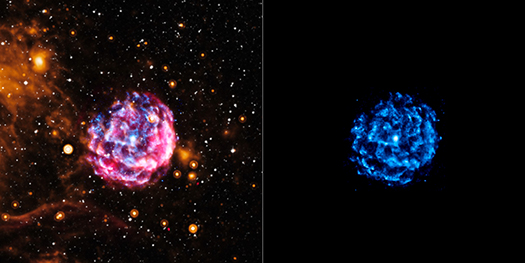
Have you ever played with magnets? You might have done an experiment where you lay a magnet onto a table and place an iron nail nearby. If you push the magnet slowly toward the nail, there will come a point when the nail jumps across and sticks to the magnet.
That's because magnets have something invisible that extends all around them, called a 'magnetic field'. It can cause a pushing or pulling force on other objects, even if the magnet isn't actually touching them.
The most powerful magnets in the Universe are called magnetars. These are tiny, super-compact stars, 50 times more massive than our Sun, squashed into a ball just 20 kilometrers across. (That's about the size of a small city!)
Astronomers think magnetars may be created when some massive stars die in a supernova explosion. The star's gases blow out into space creating a colourful cloud like the one in this picture, called Kes 73. At the same time, the core of the star squashes down to form a magentar.
At the centrer of the cosmic cloud in this photograph lies a tiny magnetar. But what this star lacks in size it makes up for in energy, shooting out powerful (http://www.unawe.org/kids/unawe1381/) jets of X-rays every few seconds! You can see the X-ray jets in blue on this photograph.
Cool Fact: Astronomers believe there could currently be more than 30 million magnetars dotted across the Milky Way!
Watch the video podcast
Do you want to learn more about this topic?
Visit the Chandra field guide or send us your questions in an email: cxcpub@cfa.harvard.edu
In cooperation with Space Scoop: Bringing news from across the Universe to children all around the world. Universe Awareness and the Chandra X-ray Observatory
| Children & Online Privacy |



